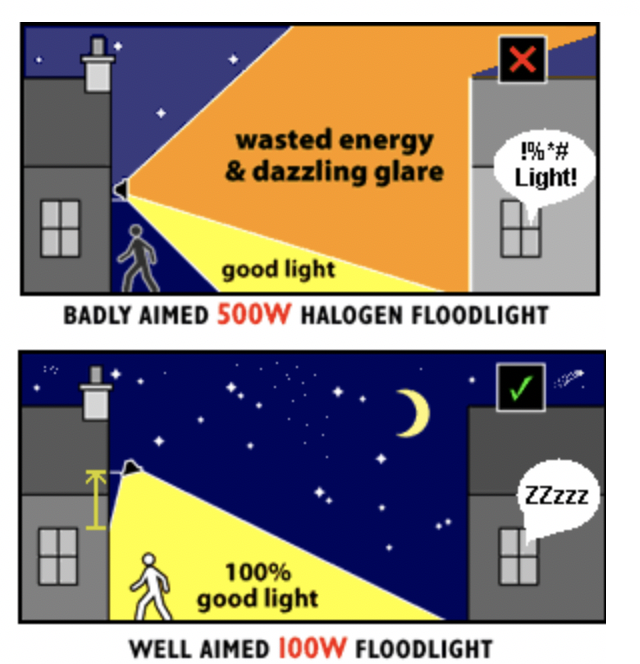Light Pollution Reduction
New ResidentialWhat is Light Pollution?
Light pollution refers to noticeable artificial light at night (ALAN), an unwelcome by-product of excessive outdoor lighting, especially vertical illuminance that includes such effects as skyglow, the brightening of the night sky, light trespass, the spilling of light beyond a property or intended lighting boundary, and glare, the obtrusive brightness of light viewed against an unlit background.[1] The residential building sector contributes to light pollution through a variety of sources, including architectural and landscape lighting, interior nighttime lighting, and security lighting.
The following includes a list of several negative impacts of light pollution.
- Interferes with wildlife migratory and breeding patterns, impacting nighttime ecosystems and biodiversity.[2]
- Wastes energy and contributes to greenhouse gas emissions.
- Leads to glare issues and unsafe driving conditions, particularly for older motorists.
- Impacts human metabolism and disrupts sleep through constant exposure to artificial light, particularly light from the blue end of the spectrum.[3]
- Reduces ability to view stars and interferes with astronomical observatories. [4]
- Causes a nuisance to neighboring properties by casting unwanted nighttime glare into windows.

Figure 1: Effects of light pollution (Source: Florida Atlantic University)
How to reduce light pollution?
The first steps to reducing light pollution are to evaluate the outdoor lighting requirements of your residence (i.e., aesthetics, security, or utility), to eliminate unnecessary lighting, and to strategically place energy-efficient lighting and controls to meet the remaining lighting requirements (see High-Efficiency Lighting and Networked Lighting Controls).
Downlighting refers to a lighting strategy that directs light down and only lights the predetermined area; therefore reducing light pollution. Technologies to reduce light pollution also include full cutoff luminaires, low-reflectance surfaces, and low-angle spotlights.3 Cutoff luminaires have no direct uplight, help eliminate glare, and efficiently direct lighting down to the predetermined area.
General guidelines for efficient outdoor lighting include:
- Consider location and surrounding areas during the lighting design, and select luminaires, locations, and orientations that minimize light trespass onto adjacent properties.
- Replace traditional HIDs (high-intensity discharge) luminaires and lamps, including high-pressure sodium and metal halide lamps, with EnergyStar certified outdoor LEDs.
- Consider installing solar powered outdoor LED lights for outdoor pathways.
- Aim floodlight angles low so that the entire beam falls within the intended lighted area and direct light downward whenever possible.
- Use well-shielded luminaires and lamps, and other control devices when up-lighting is required to maximize the efficiency of the light source (e.g., reflectors, deflectors, and covers).
- Couple outdoor lightings systems, with lighting controls such as motion detectors, photosensors, and schedule controls, to enhance an energy efficiency and security.
- Adjust timers to the minimum period necessary and dim or switch lights off when not needed to save energy and cut electric bills.
- Plan for backup power for critical lighting needs during a power outage, such as emergency and night-time lighting (see Energy Storage and Back-up Power Generation).
- Commission and regularly re-commission all lighting systems and controls to optimize performance and energy savings.
For project specific advice, consult the Illuminating Engineering Society’s lighting design guides, which provide lighting professionals with standards and recommended best practices for a variety of lighting applications.
Benefits
Efficient outdoor lighting design helps to reduce light pollution, and its associated adverse effects including wasted energy reduced nighttime visibility for astronomers and scientists, disruption of nocturnal wildlife and ecology, and impacts on human health and well-being.[5]
Costs
The costs of implementing lighting designs and technologies that reduce light pollution vary depending on the selection of lighting sources, fixtures, and controls. Effective and efficient outdoor lighting solutions are not always the least expensive option, but as with any comprehensive cost evaluation, operating costs, including energy savings, lifetime performance, and maintenance, are essential factors to consider.[6] Check the New Jersey Office of Clean Energy for available incentives.
Resiliency
Reducing light pollution provides energy savings and reduces reliance and stress on the electricity grid. Outdoor lighting designs that supplement solar-powered LED lighting technologies for a portion of regular lighting requirements (e.g., pedestrian pathways) and plan for backup power for critical lighting needs further reduce stress on the grid, especially in the event of a power outage.
[1] The Lighting Research Center, Rensselaer Polytechnic Institute. http://www.lrc.rpi.edu/programs/transportation/pdf/lightPollution/Seminarpresentation.pdf (accessed October 22, 2018).
[2] Gaston KJ, Visser ME, Ho ̈lker F. 2015 The biological impacts of artificial light at night: the research challenge. Phil. Trans. R. Soc. B 370: 20140133. http://dx.doi.org/10.1098/rstb.2014.0133 (accessed Dec 19, 2018).
[3] Illuminating Engineering Society, International Dark Sky Association. Model Lighting Ordinance. http://darksky.org/wp-content/uploads/bsk-pdf-manager/16_MLO_FINAL_JUNE2011.PDF (accessed October 22, 2018)
[4] Cornell University, Astronomy Department. 2018. “Ask an Astronomer: How does light pollution affect astronomers?” http://curious.astro.cornell.edu/about-us/116-observational-astronomy/stargazing/professional-observers/712-how-does-light-pollution-affect-astronomers-intermediate (accessed Dec 20, 2018).
3 LEED v4 for Building Design and Construction. https://www.usgbc.org/sites/default/files/LEED%20v4%20BDC_07.2.18_current.pdf (accessed Oct. 22, 2018).
[5] International Dark-Sky Association. Light Pollution. http://darksky.org/light-pollution/ (accessed October 22, 2018).
[6] Illuminating Engineering Society. IES Lighting Handbook, 10th Edition. https://www.ies.org/handbook/DiLaura/Introduction%20to%20the%20IES%20Handbook%20PDF.pdf (accessed October 22, 2018).
